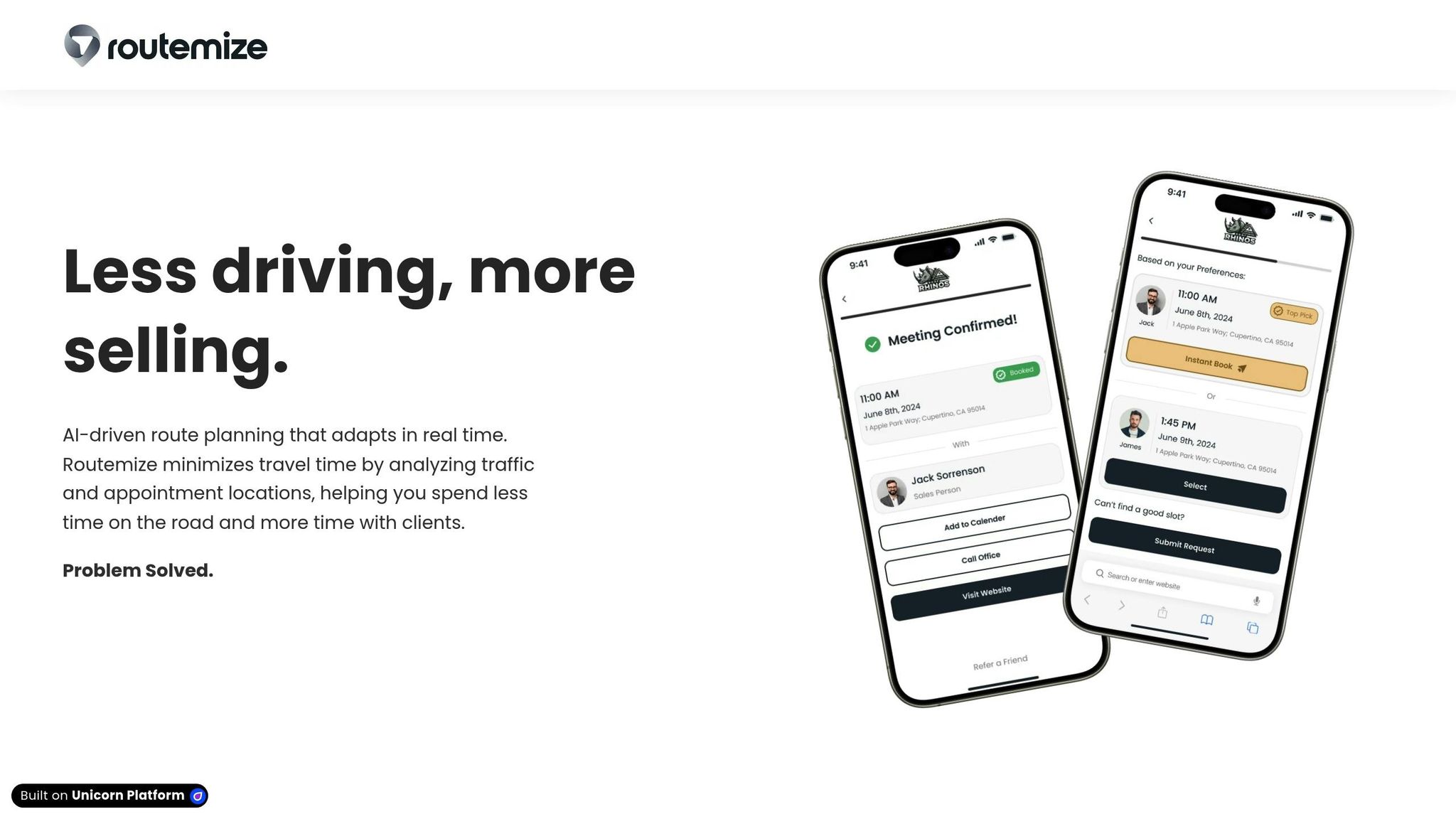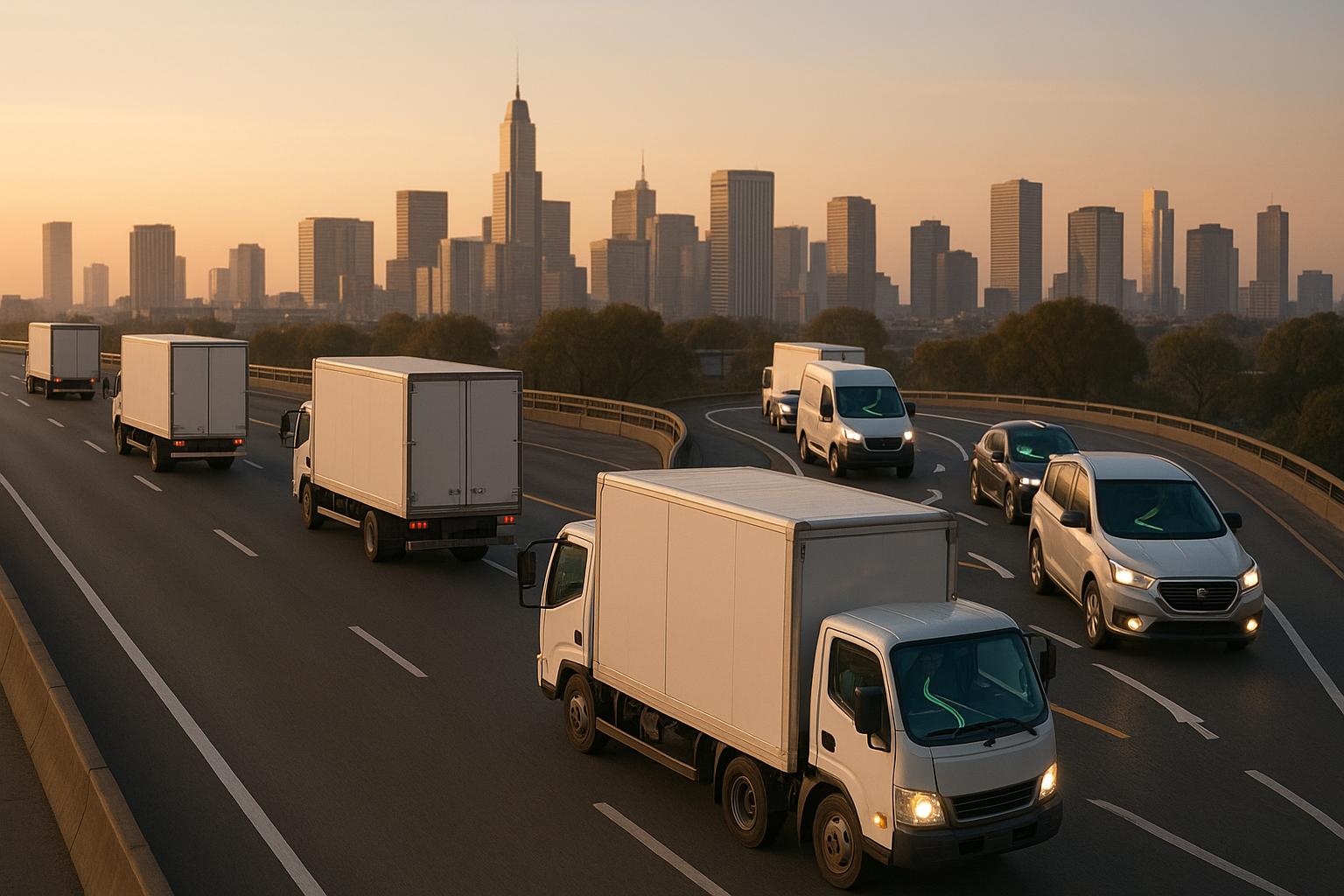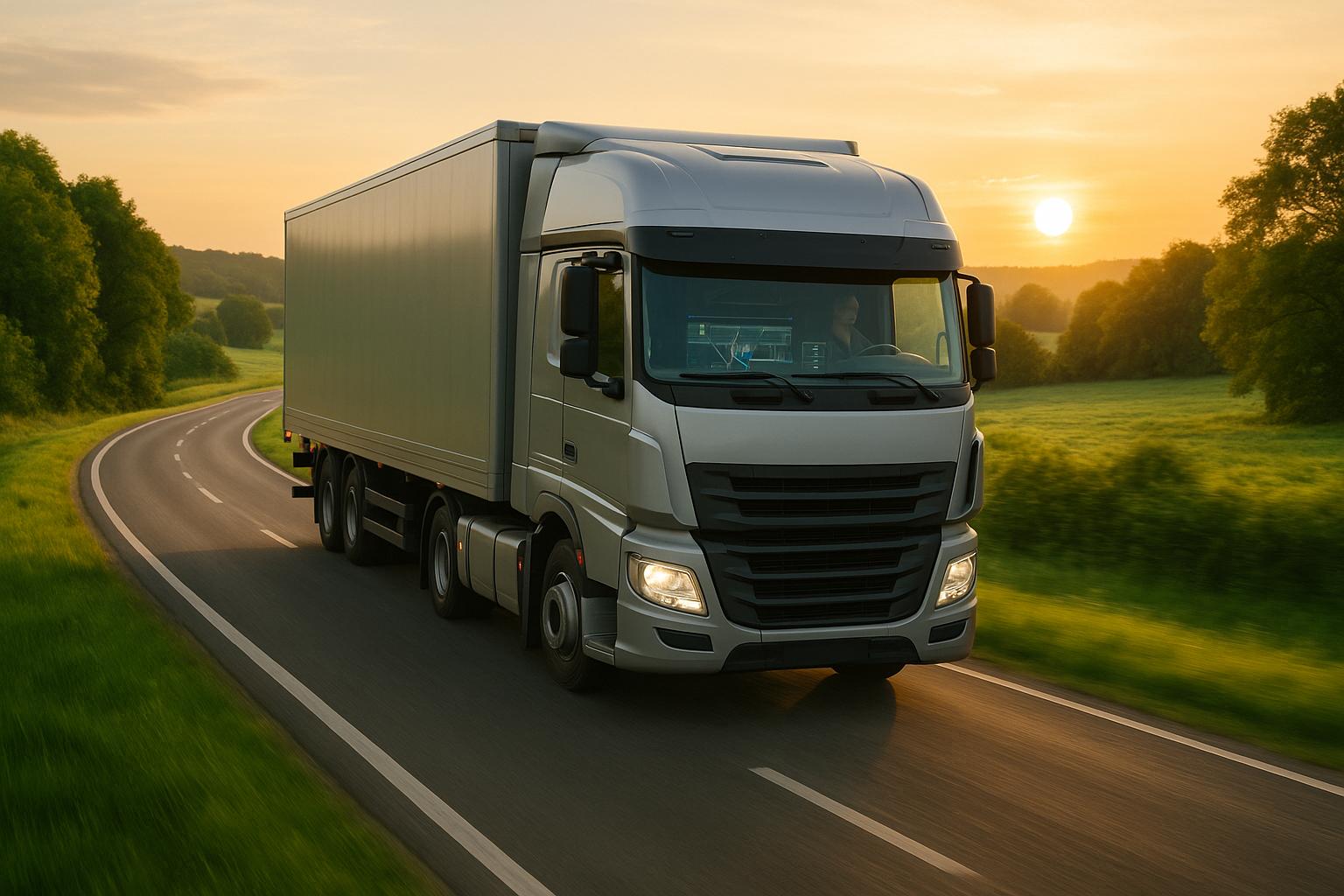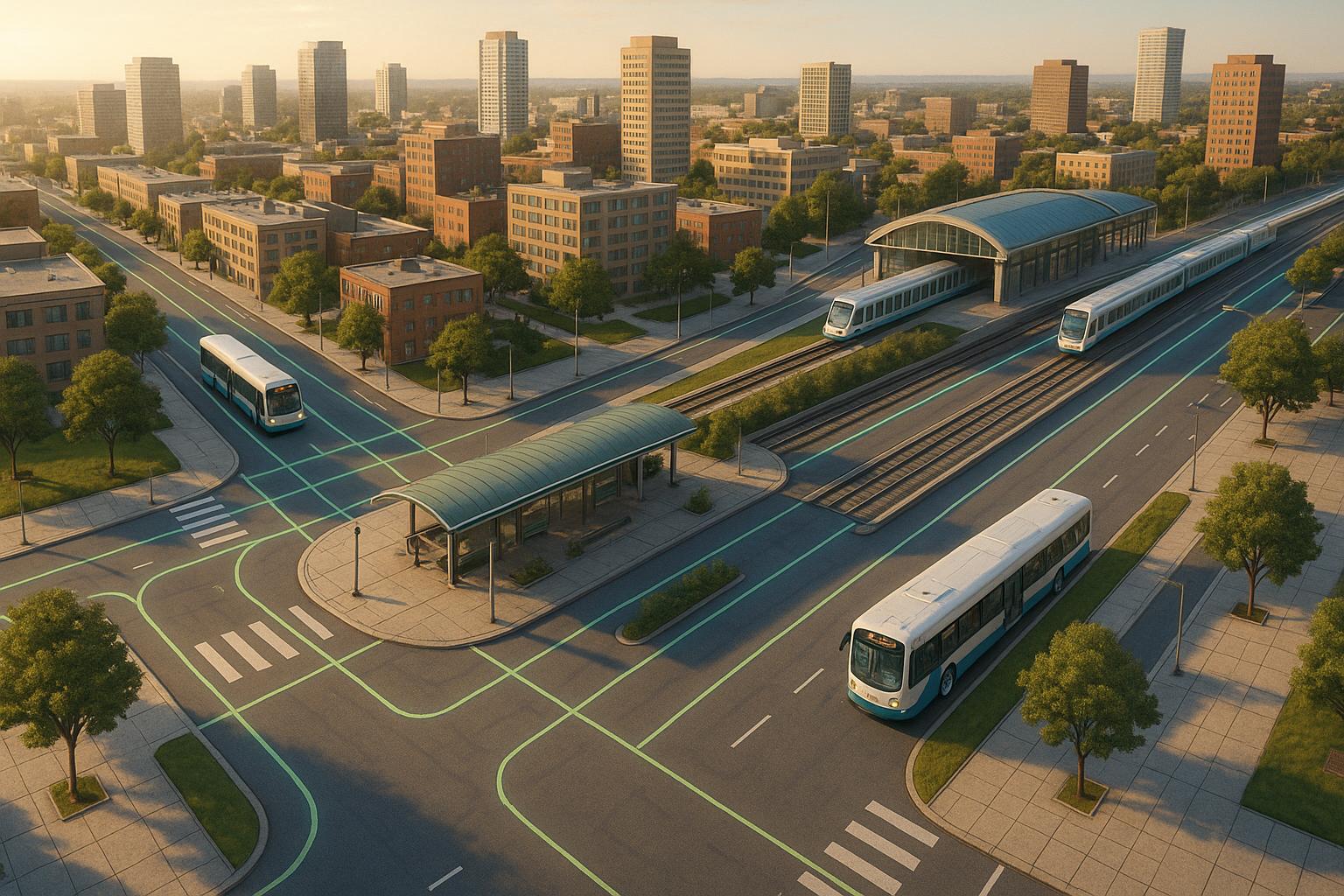AI is transforming delivery logistics by making multi-stop delivery time estimates more accurate, efficient, and cost-effective. Here’s how:
- Faster Deliveries: AI reduces delivery times by up to 30% by optimizing routes based on real-time traffic, weather, and historical data.
- Cost Savings: Companies save up to 15% on logistics costs by cutting unnecessary mileage, fuel consumption, and maintenance expenses.
- Improved Accuracy: AI minimizes forecasting errors by 30–50%, ensuring deliveries stay on schedule and reducing failed delivery costs.
- Customer Satisfaction: With 84% of customers prioritizing shipping options, AI helps businesses meet delivery expectations, boosting trust and loyalty.
For example, UPS's ORION system saves drivers 6-8 miles daily, cutting emissions by 100,000 metric tons annually. Tools like Routemize offer dynamic route updates, stop clustering, and predictive analytics to optimize delivery operations.
Why it matters: AI ensures faster, more reliable deliveries while reducing costs, making it essential for businesses to stay competitive.
Cut Delivery Times in Half: How AI Is Changing Logistics Forever!
Core AI Features for Time Estimates
AI systems improve delivery time predictions by leveraging three interconnected technologies that work together to produce highly accurate estimates.
Live Traffic Monitoring
AI-driven traffic monitoring takes route planning to the next level by analyzing data from various sources like traffic cameras, GPS signals, and road sensors. This creates a detailed picture of real-time traffic conditions. Cities using AI-based traffic systems have reported travel time reductions ranging from 25% to 40%.
Pattern Learning from Past Data
In addition to live monitoring, AI excels at identifying patterns in historical data, which plays a big role in improving delivery predictions. By analyzing massive datasets of past deliveries, AI can uncover trends that traditional methods might miss. Businesses adopting AI-powered routing systems have seen delivery speeds improve by as much as 30% and operational costs drop by 15%. For example, by 2024, Amazon offered same-day or next-day delivery for nearly 60% of Prime member orders in the 60 largest U.S. metropolitan areas.
| Data Type | How AI Enhances Delivery |
|---|---|
| Historical Routes | Finds the best delivery sequences |
| Weather Patterns | Anticipates seasonal delays |
| Delivery Times | Refines time window accuracy |
| Vehicle Performance | Boosts fleet efficiency |
These insights allow for real-time route adjustments, ensuring deliveries stay on track.
Instant Route Updates
What sets modern AI apart is its ability to provide instant route updates. DHL's use of AI and IoT in India showcases this advantage, cutting transit times by 20% and reducing fuel and maintenance expenses. Traditional routing inefficiencies can increase delivery costs by up to 30% globally, but AI-powered algorithms can slash those costs by as much as 40% by minimizing unnecessary mileage and improving vehicle utilization.
Benefits of AI Time Estimates
AI-powered time estimates, built on advanced traffic monitoring and data analytics, bring measurable improvements to delivery operations.
Time Management Improvements
AI systems enhance route planning and resource allocation, helping companies grow up to three times faster. With nearly two-thirds of global shoppers expecting 24-hour delivery by 2024, optimizing delivery operations with AI becomes a game-changer:
| Time Management Factor | Impact |
|---|---|
| Route Efficiency | Significant gains in routing efficiency |
| Resource Utilization | 15% drop in operational costs |
| Driver Productivity | 40% boost in route efficiency |
| Customer Satisfaction | 96% of customers value delivery speed |
Better Prediction Accuracy
AI also shines when it comes to forecasting. According to McKinsey, AI reduces forecasting errors by 30–50%. A great example is Border States, the sixth-largest electrical distributor in the U.S., which automated 90% of its purchase order processing within just three months. This level of precision helps prevent delivery failures, which cost retailers $17.20 for every failed domestic delivery. More accurate predictions directly translate to fewer errors and lower costs.
Cost Reduction
The last mile and rapid deliveries account for 53% of total B2C shipping costs. AI helps cut these expenses by analyzing real-time data and historical trends, delivering savings in several areas:
- 15% reduction in logistics costs
- Lower fuel consumption through optimized routes
- Reduced vehicle maintenance expenses
- Decreased overtime costs
These cost savings are critical for improving customer retention, especially since 61% of customers abandon purchases due to slow shipping. For 85% of retail executives, reducing the cost per order remains the top priority in last-mile delivery.
sbb-itb-7020db0
Setting Up AI Delivery Systems
AI-powered delivery systems are revolutionizing logistics, especially when it comes to improving delivery time accuracy. By leveraging modern AI, businesses can optimize routes and reduce fuel costs by as much as 15% through smarter planning.
Key Features for AI Route Planning
To get the most out of AI route planning, certain features are absolutely essential. Here's a breakdown of what to look for:
| Feature | Purpose | Impact |
|---|---|---|
| Real-Time Traffic Integration | Adjust routes dynamically based on live traffic | Cuts down delays caused by congestion |
| Weather Pattern Analysis | Anticipate and manage weather-related delays | Enhances ETA accuracy |
| Multi-Stop Optimization | Optimizes the sequence of stops for efficiency | Reduces delivery costs by up to 40% |
| Predictive Analytics | Plans ahead using historical data | Improves the reliability of delivery schedules |
| Driver Performance Monitoring | Tracks safety and efficiency metrics | Boosts completion rates and overall safety |
Steps to Set Up an AI System
Getting started with an AI-driven delivery system involves a few critical steps:
-
Data Collection and Integration
Gather all relevant delivery data, such as historical routes, delivery times, and customer locations. This data forms the foundation for accurate AI predictions. -
System Integration
Link your AI routing platform with existing tools like ERP and warehouse management systems to ensure seamless data sharing and workflow efficiency. -
Pilot Testing
Start small by running a pilot program. This allows you to measure how AI impacts operations and refine processes before rolling out at scale.
Once these steps are in place, businesses can take full advantage of AI's capabilities to streamline their delivery operations.
Spotlight on Routemize

Routemize is a standout example of how AI can transform delivery systems. Its advanced features are designed to integrate smoothly into existing setups, offering powerful tools to optimize delivery routes.
Some of its standout features include:
- Dynamic route optimization: Adjusts routes in real-time based on traffic and road conditions.
- Intelligent stop clustering: Groups stops efficiently to save time and resources.
- Pattern-based learning: Uses historical data to refine route planning over time.
- Automated dispatch optimization: Streamlines the assignment of deliveries for maximum efficiency.
Routemize takes into account a wide range of factors - traffic flow, delivery time windows, and even vehicle capacity - to create the most efficient routes possible. This approach mirrors strategies like UPS's "no-left-turn" policy, which significantly cut fuel costs and improved delivery performance. By reducing idle time and enhancing route accuracy, platforms like Routemize are paving the way for smarter logistics.
Conclusion
Main Points Review
AI has made a profound impact on multi-stop delivery time estimates, reshaping how businesses approach efficiency and cost management. From streamlining route planning to transforming delivery operations, AI has proven itself indispensable. Systems like UPS's ORION highlight just how much potential AI holds in this space.
"AI route optimization enhances operational efficiency by reducing fuel consumption, improving delivery times, and lowering transportation costs." - Lumenalta
These advancements pave the way for even more exciting developments in the future.
Future Developments
With the AI market expected to grow at a rate of 22.26% between 2022 and 2027, the stage is set for continuous innovation. Some key advancements on the horizon include:
| Advancement | Impact | Timeline |
|---|---|---|
| Predictive AI Routing | Identifies and mitigates delays early | Near-term |
| Autonomous Vehicle Integration | Minimizes reliance on human drivers | Mid-term |
| Eco-friendly Optimization | Cuts emissions and fuel consumption | Ongoing |
| IoT Device Integration | Boosts real-time tracking capabilities | Near-term |
Platforms like Routemize are leading the charge, leveraging tools like intelligent stop clustering and pattern-based learning to refine delivery optimization. These technologies not only align with emerging trends but also help businesses maintain a competitive edge.
"By evaluating and integrating advanced technologies like agentic AI and intelligent simulation, organizations can achieve specific goals, foster innovation and achieve long-term competitive advantage." - Christian Titze, VP Analyst and Chief of Research in Gartner's Supply Chain practice
As AI continues to mature, it promises to deliver even more advanced solutions, further enhancing delivery accuracy and operational efficiency.
FAQs
How does AI help make multi-stop deliveries faster and more efficient?
AI takes the complexity out of multi-stop deliveries by leveraging real-time data and machine learning to fine-tune routes as conditions change. It evaluates traffic patterns, weather updates, and road closures in real time, enabling drivers to bypass delays and stay on track.
Beyond that, AI factors in delivery time windows, vehicle load capacities, and fuel efficiency to map out the smartest routes. The result? Shorter travel times, lower operational costs, and more precise delivery estimates - all of which contribute to happier customers.
How do AI-powered delivery systems help businesses save money and improve customer satisfaction?
AI-powered delivery systems offer businesses smarter ways to handle multi-stop routes, cutting costs and improving customer satisfaction. By analyzing real-time data - like traffic, weather, and delivery locations - AI can fine-tune routes to minimize travel time, reduce fuel use, and lower operational expenses.
For customers, these systems bring transparency and convenience. Features like precise delivery time estimates and real-time tracking keep customers informed and in control, enhancing their experience. This not only meets growing expectations but also strengthens trust and loyalty, helping businesses retain more customers.
How can businesses successfully integrate AI into their delivery operations?
To bring AI into delivery operations successfully, businesses should begin by closely examining their existing workflows. This helps pinpoint where AI can have the biggest influence - whether it’s enhancing route planning or providing more precise delivery time predictions. Setting clear objectives is essential to ensure the AI implementation supports the company’s broader goals.
Once priorities are identified, the next step is to adopt AI tools that can process real-time data and improve decision-making. Equally important is training employees to use these tools effectively and keeping a close eye on their performance. Regularly updating and fine-tuning AI systems will ensure they continue to deliver value and streamline delivery processes.


